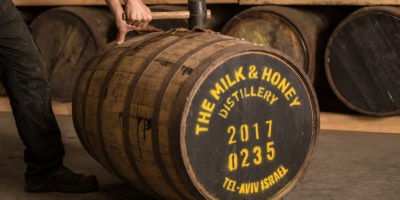The whiskey world is getting larger by the day which makes it hard for even experts to keep up. Fortunately, writers like author Lew Bryson want to help you up your knowledge of the water of life. In his new book, Whiskey Master Class, Bryson brings readers with him on a world tour of whiskey styles, educating imbibers on different categories and rules of production. He breaks down different ingredients, distillation techniques and maturation methods. Furthermore, he introduces readers to many of the makers who produce our favorite spirits.
Here are some of the subjects to survey—and some of the spirits to do it with—when you’re thirsty for more knowledge.
Evaluating the Craft Scene Today
The largest recent change to the whiskey industry is the growth of the craft segment. “There weren’t many craft whiskeys that were more than a curiosity five years ago, and most were overpriced, over-oaked under-performers,” says Bryson. “That’s changed. There are craft whiskeys that can stand up to similarly aged whiskeys from established distilleries; Rock Town and New Riff come to mind.”
Grains at Rock Town Distillery /Photo Credit: Rock Town Distillery
Of course, it’s not just that there are new producers, it’s that they’re doing new things. “More interesting to me, there are craft whiskeys that are truly different from category standards: heirloom grains, mash bill ratios, aging regimens, filtering, and more,” Bryson continues. “Westland’s a prominent example, with their locally-grown heritage grain program and the Garryanna oak aging with a malt whiskey. My local rye, Dad’s Hat, is made with such a different mash bill—80% rye, 15% malt, 5% rye malt—that it isn’t always recognized as a rye whiskey in blind tastings.”
With the evolution of craft, there’s been a corresponding shift in what the major producers have been doing as well. “They’ve adapted to the arrival of the new craft distillers a lot quicker, smarter, and better than the big brewers did to craft beer,” he says. “We’ve seen new releases, improvements in standard releases, and adaption to the market realities.” That’s been a big win for whiskey drinkers, even if it has resulted in the scarcity of some of our favorite drams.
Overlooked Aspects of Great Whiskey
Once the maturation of a whiskey is complete, the final product is done, right? Well, not so much.Bryson believes the period between that conclusion and the whiskey’s bottling is the most overlooked area of whiskey production today, including selection of stocks, blending and proofing.
Filling samples at Westland Distillery /Photo Credit: Westland Distillery
“Thanks to the chaotic reality of whiskey making, every barrel tastes a little different, and while you can group them to some extent—age, warehouse, vintage—there will be outliers,” says Bryson. “That’s why the person doing the blending has such a hard job. I mean, those differences are why the same yeast, mash bill, still, and barrels will produce genuinely different bourbons; if you don’t understand that, you really don’t understand whiskey. Proofing is what finishes it off. Adding more or less—flavorless, odor-free—water to a whiskey until it presents exactly the aroma and flavor you want is a little bit of genius, and most people think it’s just about money. I mean, it is, sometimes, but when you get off the bottom shelf, and into those 94.7, 101, 107 proof bottles, it’s about flavor.”
Other Intangibles
Another overlooked area is what Bryson refers to as the intangibles of whiskey. “It’s a polite way of saying, ‘things people don’t agree on,'” he says.
First and foremost on that list is the idea of terroir; a debate we’ve covered in detail. “There’s the water, the aging climate, the grain sources, there’s even the climate for stilling and fermenting, it all has an effect,” says Bryson. “The late Dave Pickerell was of the opinion that we’re only starting to see the effects of terroir in whiskey because we’re only now tasting whiskey made from small enough plots of grain that we can taste a difference. Hillrock, where Dave worked, and Whiskey Acres, where Nick Nagele and his family are taking it down to sections of individual fields, are going to be on the front of that.”
Cream of the Craft Crop
While scores of craft whiskey producers have come of age, certainly some stand out more than others. “New Riff just impresses the hell out of me,” says Bryson. “Two years ago, I said, and I wasn’t alone, that there was no point to craft producers trying to go toe-to-toe with established producers in bourbon and rye. They proved me wrong.”
Bottles at New Riff Distillery /Photo Credit: New Riff Distillery
Bryson counts Westward Single Malt as another favorite, along with Willett—if we’re deciding to call them craft—and Peerless, whose whiskeys he says are “pretty damned special,” even if he isn’t a fan of their pricing. And he has more bottles for you to nab, too.
“Ranger Creek’s young ryes are hearty slaps to the chops that wake up my snoozing taste buds,” says Bryson. “And a few oddball grain whiskeys: Balcones Baby Blue and Catskill Distilling’s The One And Only Buckwheat (technically not a whiskey, as buckwheat is technically not a grain) are both very different, and very good. Oh, and the Jeptha Creed Four Grain bourbon made with their Bloody Butcher corn.”
There’s no reason that the word “flavored” has to be verboten, either. It’s a mixed bag category in terms of the quality of what’s available. But Bryson believes there are some gems to be unearthed there, too. “Is it okay to talk flavored?,” he ponders. “Because the FEW Cold Cut is just genius, using cold brew to cut a whiskey to bottling proof. That’s exactly the kind of crazy shit a major producer wouldn’t have the balls to bottle, which is the best reason for craft distillers!”
More Lew Bryson Whiskey Recommendations
If you’re looking to jump ship from one category to the next, here are a few of Bryson’s suggestions:
• Bourbon drinker to scotch: “Balvenie Single Barrel 12 Year is aged in freshly-drained bourbon barrels, a great way to bridge the ocean.”
• Rye whiskey drinker to Irish: “I’ll pick one for the rye whiskey drinker, check out the Kilbeggan Small Batch, a zippy mixed mash whiskey that’s right out of the ordinary.”
• American whiskey drinker to Canadian: “You should be able to find Wiser’s 18 Year Old Canadian, it’s mellow, sweet, and delicious, one I could drink all afternoon.”
• Scotch drinker to American: “If you’re an Islay drinker, go head-to-head with McCarthy’s Single Malt from Oregon, a slamming smoky young malt.”
• Irish drinker to American: “Right out of the blue for the Irish drinker: try the Belle Meade Sherry Cask Finish bourbon. Just familiar enough, but still very American.”
This list should keep you busy for a while. Pair them with a good book at your side.
Ready to try some suggestions from Lew Bryson?
With Distiller, you’ll always know what’s in the bottle before you spend a cent. Rate, Review, and Discover spirits. Head on over to Distiller, or download the app for iOS and Android today!
Want to enjoy Distiller ad-free? Join Distiller Pro today to support the Distiller platform and keep ads off of your screen.



